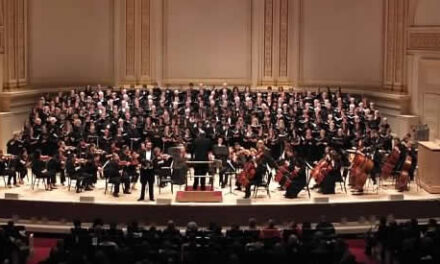For the whole fall season, I had been looking forward to an October 21 recital in the warm and sonorous Ernest W. Nelson Room on the East Duke Campus. The hall is regarded as the finest place in the Triangle to hear chamber music. Before its success drove it to the larger Reynolds Theatre on the main campus, the Chamber Arts Society hosted all the world’s great quartets on that wonderful pine soundboard-like stage.
Violinst Hsiao-mei Ku, of the Ciompi Quartet, can always be counted upon for solid musicianship. Having read and heard colleagues’ praise for both his musicianship and virtuosity, I especially looked forward to my first chance to hear pianist Ray Kilburn.
This season, the entire lower floor of Nelson has new, nearly solid wooden-backed chairs, built on thin metal frames, and a smaller, thin rug has been put down. I took a seat in the balcony and settled back to bask in the glow of great chamber music. As the keyboard’s dynamics rose above piano, I stiffened with horror. After the first piece, I watched as groups of long-time Nelson attendees shifted their locations. After each work, many would switch again. At intermission, many fled to the balcony to join me. My off-duty colleagues expressed their shock and disbelief at intermission: “They’ve turned the place into an echo chamber!” A large crowd had masked the extent of the problem at the recent Ciompi performance but a third-full house – and the addition of the piano – revealed the ugly desecration.
Allowing for the handicap of the altered acoustics, Ku and Kilburn set high standards. The piano lid was fully up and as long as the piano was below forte, the balance good. At forte, the room’s echo effect swamped the proceedings. Ku had a burnished dark tone in the opening Mozart Sonata in E Minor, K.304. Her phrasing was stylish and her fast passagework was clean and immaculate. Kilburn’s pianism had crystalline clarity that was perfect for Mozart, except when the room’s echo interfered. I loved the soaring violin melody near the end of the second movement.
Next came a warm performance of Brahms First Sonata in G, Op. 78. The first movement was dominated by a feeling of wistful nostalgia. Ku’s intonation was both precise and expressive, even in high, exposed passages. The Adagio opened with piercing piano notes, part of an extended introduction before the violin entered in an autumnal mode. There was some lovely “pp” playing, and the gentle quiet ending was delightful. Room echo marred enjoyment of the livelier and louder last movement.
Next, Ku discussed the background of “Improvisation,” by Kang-nian Tang, a Chinese violinist, composer and conductor who now lives in Canada. Before coming to the Western Hemisphere, he was based in the Shanghai Opera House, where he served in all three capacities. Ku met the composer two months ago and asked to see some of his music. “Improvisation” arrived only two weeks ago. She said that it is based on a Chinese “yang-gee” dance that is called “dream dancing with a dragon.” A former research assistant believes that it was a Yang ko dance, popular among rural folk. The composition opens with rapid bowing, some of which seemed like a sort of Chinese hoedown. A slower section features swirling high notes, followed by a section in a slower, romantic mood. A faster section has a pounding rhythm in the piano with a high treble part and ends with flourish with a fast run of the fingers from the treble to the bass.
The concert ended with a fine performance of Prokofiev’s Second Sonata in D, Op. 94a, which also exists in a version for flute. The piano was restrained in the opening, which Ku phrased with passion and style. The exposed high notes were precise. The Scherzo was angular and swirling, with lots of fast high notes. The Andante was gentle and poignant. The last movement sounded ironic and featured a driving rhythm.
I hope that the staff at Duke will quickly move to correct the Nelson Music Room’s echo-chamber effect. I look forward to hearing both artists under less trying circumstances.












